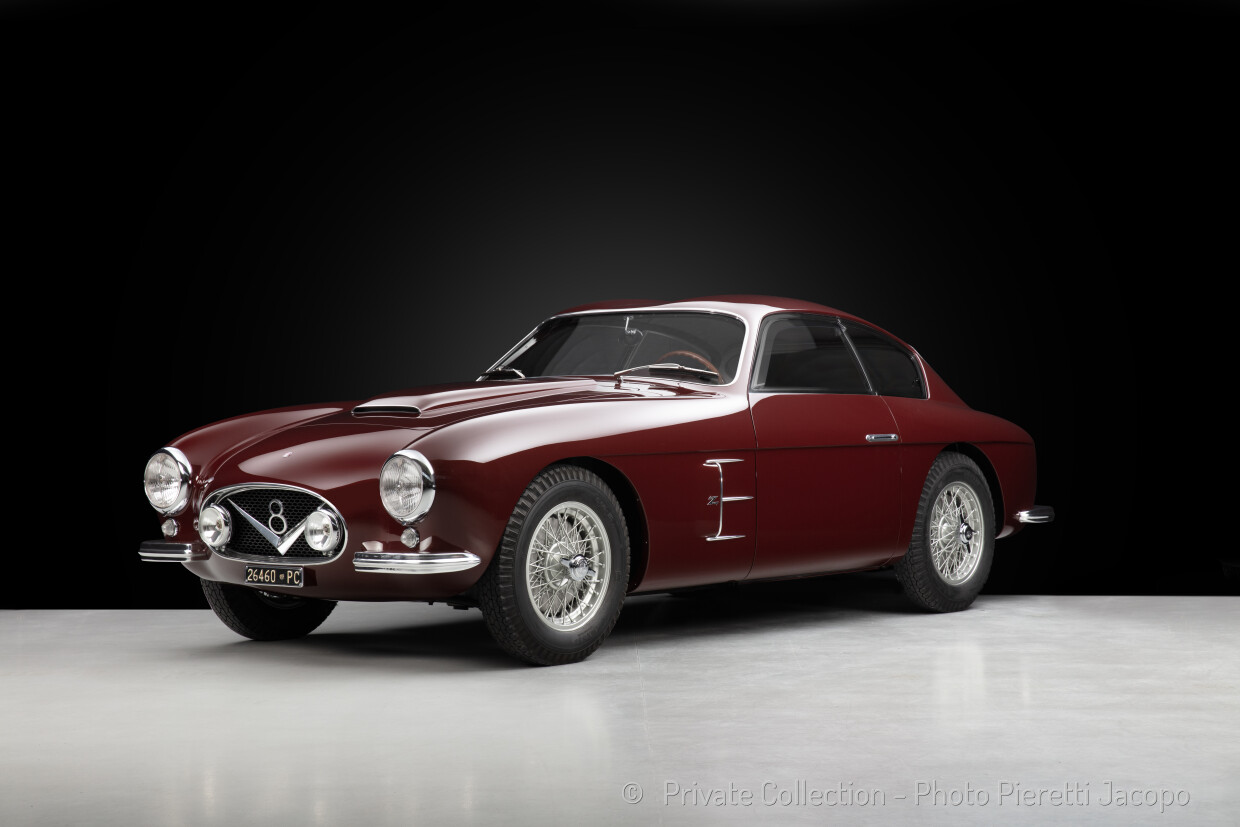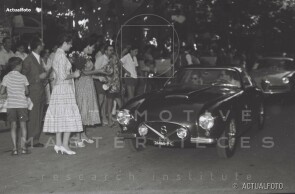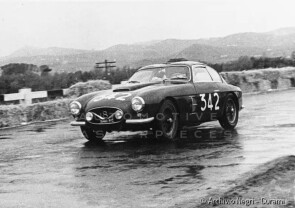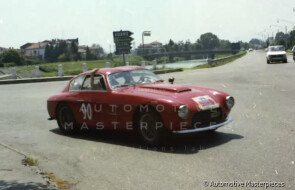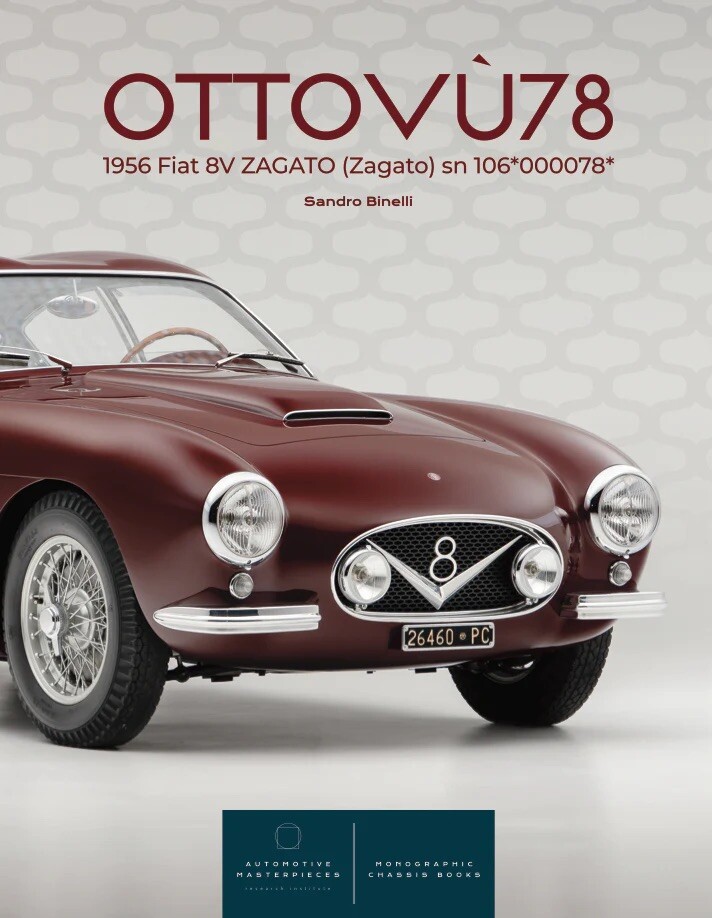
1956 Fiat 8V ZAGATO
ON/OFF
Why am I an Automotive Masterpiece?
G. Team cars
Scuderia Sant’Ambroeus (I)
L. Limited edition cars
no. 6 manufactured. Only 6 "double-bubble" roof were built.
In the postwar period, Fiat was working on an eight-cylinder engine internally known as Tipo 106. The engine was originally designed by Dante Giacosa for a luxury sedan, but that project was stopped. Rudolf Hruska, at the time working at the S.I.A.T.A., was given the task to design a car around the V8 engine. The development took place in absolute secrecy. As not to stress the experimental department of Fiat, production of the chassis was also taken up by S.I.A.T.A. Styled by chief designer Fabio Luigi Rapi, the Fiat 8V or “Otto Vù” was presented to the Italian press in February 1952 and first exhibited the following March at the Geneva Motor Show. The car shapes saw several changes in time: the prototype used an art deco grill extending into the hood which initially characterized the examples of the first series. A second series was made featuring four headlights with some of the later cars having a full-width windscreen. A high-performance coupé, destined to compete in the GT class: the 2-liter 8V model was a departure from the usual Fiat production. It was really welcomed by Italian private drivers, it inspired the tuners and it was, in a word, the car to beat in the 2-liter class, also thanks to the special versions built by Zagato or Siata. The Fiat V8 had a 70° V configuration of 1996 cc of displacement, at 5600 rpm the engine produced 105 hp in standard form with double two-barrel Weber 36 DCS carburetors, giving a top speed of 190 km/h. Some engines were fitted with two huge four-throat Weber 36 IF4/C carburetors offering 120 hp, but the intake manifold was very rare. The Fiat 8V is the only eight-cylinder built by Fiat. The engine was connected to a four speed gearbox. The car had independent suspension all round reworking the Fiat 1100 ones and drum brakes on four wheels. As the body was welded to the chassis it was a semi-unitary construction. Only 114 of these high-performance coupés had been produced, 64 of them with a “Fiat Carrozzerie Speciali” body, 34 first series and 30 second series. It was made available anyway in different body styles, offered by the factory and by various coachbuilders like Zagato, Pinin Farina, Ghia and Vignale. The production ceased in 1954.
The relationship between the Fiat 8V and Zagato began in 1952 when Ovidio Capelli, gentleman driver and FIAT dealer in Milan, commissioned a special body for his 8V chassis no. 000002 to Zagato. Cappelli was looking for a car that was lighter and faster than the production 8V designed by Fabio Luigi Rapi. The one-off was built in aluminum, embodied an “essential beauty” in terms of design, and had excellent racing qualities thanks to its lightness and agility. Cappelli’s victories convinced Fiat and Zagato to build together a small series of the 8V, leader in the GT class. Elio Zagato himself, as a perfect front man for the family business, also achieved good racing results with these cars. Carrozzeria Zagato bodied 31 cars, of which 22 were new from the bare chassis, and the other 9 were re-bodied examples originally with Fiat bodywork; within this group, there were 5 “Elaborata” (derived from the Rapi-designed model), and a one-off spider. In the Zagato philosophy the most important aspect of the design “language” was, since the very beginning, rationalism. The “rationalist” body shape was intended to give the design maximum efficiency to achieve its best possible performance. The aerodynamic solutions adopted in the design stage were intended to harmonize form and function. One of the principles that made Zagato design recognizable was the “double bubble” roof that was used from the beginning of 1950’s. It consisted in a particular silhouette with two parallel humps running from the top of the windshield to the beginning of the rear window. This lowered the front section of the bodywork while retaining sufficient clearance for the driver’s head (wearing a helmet). Zagato built six FIAT 8V cars with this bodywork which became an instantly recognizable design element from the 1960s onward.
On January 2nd, 1956, chassis 106*000078* was delivered to Carrozzeria Zagato for assembly. It was the second of the six “double bubble”. The body was all-aluminum with clean, ‘rationalist’ aerodynamic lines, flush door handles, plexi-glass windows, a large air intake on the bonnet and an oval grille that incorporated the fog lights. On this car Zagato introduced side vent with three horizontal blades, to extract hot air from the engine bay; it closely resembled sn 106*000026*, which had four chrome blades instead of three. The V8 engine developed 115 hp, ten more than the one installed in earlier examples. The car was “born to run” the Mille Miglia and assigned by Zagato to Count Dore Leto di Priolo, racing for the Scuderia Ambrosiana but plans suddenly changed. On April 21, 1956, Elio Zagato, as a member of the Scuderia Ambrosiana, sold the car to his teammate Mario Muselli, through Franco Cornacchia’s FIAT dealership for 2,505,000 Lire. Muselli registered it with its first plate PC 26460 and applied to participate in the 1956 Mille Miglia. The car raced with number 342, driven by Mario “Wotan” Ferrini and Sergio Rabuffi for the Scuderia Sant Ambroeus, achieved a 47th place OA and 9th place in the GT up to 2 liters class. Following weeks, chassis 106*000078* shed its race car guise and, as an attractive sports car, participated in the Concorso Internazionale d’Eleganza per Automobili in Rimini. The car, with Sanzio Nicolini, took a 1st place in the “two-door, two-seater closed sports car” class, demonstrating its. Zagato’s “essential beauty”. Afterwards, it was registered in Rome to Pietro Bernabei for a short period and soon sold to Giuseppe Esposto of Ancona, where the car remained for about ten years, changing hands. In September 1960 it went back to races, participating in the II Coppa Fagioli with its owner, the Scuderia Marche’s driver Lanfranco Revel who easily took the overall victory. Chassis 106*000078* was sold a few months later to the Forastieri dealer and in January 1962 to Franco Mercatali. According to historical sources, the 8V was first entrusted to specialist Ovidio Pacini to fine-tune the mechanics and was modified by a local coachbuilder, maybe following an accident, with a new front end vaguely resembling the Ferrari by Pininfarina of that era. Mercatali participated with the now modified car in the VII Coppa Azienda di Soggiorno San Benedetto/Acquaviva hillclimb. Despite a spin during the race, he was 4th overall and 1st in the GT class. On September 23, Mercatali was at the IV Coppa Luigi Fagioli, achieving a 27th place overall and 1st in the 2-liter GT class. Mercatali then sold the 8V to Enrico Saviotti; the car passed in 1966 to Franco Cardinali and was purchased by Remo Tomassini for 200,000 lire, in March 1971. The chassis 106*000078* was no longer competitive but, it gradually became recognized as a “classic”. In the second half of June 1977, it participated in the first re-enactment of the Mille Miglia on the original Brescia-Rome-Brescia route, beginning a second life in events for historical cars. Once again, the car was both racing and showing in concours d’elegance. In 2016, its current owner entrusts some of the best contemporary restorers a complex and rigorous thorough restoration of the car, to return to its pristine shape. The long and meticulous operation was ended in 2023. The car was published on the Mille Miglia’s Chassis book, volume II and on May 3rd, 2024, received a Rina Certificate for the historical research conducted by Automotive Masterpieces.
